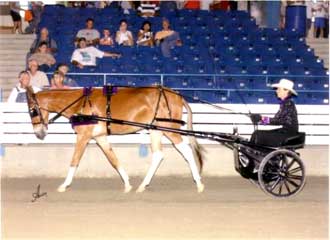Pleasure Driving
Pleasure Driving is show ring competition. Horses and/or ponies are hitched to antique vehicles or replicas. Classes or divisions are based on the animal (pony, mule, draft, mini), the driver, and/or the experience of horse or driver. Classes or divisions can be further divided by the size of the animal, the kind of vehicle, and the number of animals in the hitch; e.g. singles, pairs, unicorns, tandems, or teams. Classes are also categorized by the criteria by which they are judged. Though the total picture is evaluated, in a reinsmanship class the ability of the driver is most important; in a working class, the horse’s performance is most important; and in a turnout, the quality and appropriate¬ness of the vehicle, harness, and driver is most important. Some classes are designated specifically for gentlemen, ladies, or juniors; and some are for specific vehicles; e.g. runabouts, gigs, or coaches.
 Obstacles
Obstacles
Pleasure shows often include cones or obstacle classes in which the driver is judged on the speed and accuracy while going through a set of cone markers set inches wider than the wheel width and topped with balls. The cones are set in a manner similar to a jumping course, with left and right turns, combinations, and sometimes obstacles such as bridges. The driver who completes the course with the fewest faults (balls knocked down) in the shortest time wins. There are variations on the obstacle class category with slightly different judging criteria. In Fault and Out, the driver is eliminated when the first ball is knocked off; in Double Jeopardy, one driver drives the course one direction; his passenger drives the course in reverse. In Gamblers Choice, there is a prescribed amount of time and the obstacles have a point value. The goal is to get through as many obstacles as possible within the time allotted.Dressage
 Driven Dressage tests are included in Pleasure shows and are judged similarly to a ridden dressage test. The drivers are required to perform a set of movements which include changes of pace, circles, turns, and extensions. They are always judged individually, in a dressage ring which is either 40 x 80 or 40 x 100 meters. Judges look for three distinct trots, smooth transitions, and accuracy. The horse should demonstrate correct training.
Driven Dressage tests are included in Pleasure shows and are judged similarly to a ridden dressage test. The drivers are required to perform a set of movements which include changes of pace, circles, turns, and extensions. They are always judged individually, in a dressage ring which is either 40 x 80 or 40 x 100 meters. Judges look for three distinct trots, smooth transitions, and accuracy. The horse should demonstrate correct training.Ride and Drive
The entry is first judged in driving; the driver then gets out, produces saddle and bridle, changes tack, mounts, and is judged as a ridden entry. In combination hunter classes, the entry is asked to take one or two small jumps. This class replicates the days in which the fox hunter drove his horse or a tandem to the hunt meet. if a tandem were driven to the meet,the accompanying groom would either drive himself home, or wait with the extra horse until the rider was ready for second horses.Pleasure Driving Marathon
 if the location permits, the show will sometimes include a marathon. The entry is judged in the ring and then goes on a longer drive through the town or into the country. It is judged on turnout and performance in the ring and on the drive. The distance of the drive depends on location.
if the location permits, the show will sometimes include a marathon. The entry is judged in the ring and then goes on a longer drive through the town or into the country. It is judged on turnout and performance in the ring and on the drive. The distance of the drive depends on location.Mules and Draft Horses
Draft horses and mules are included in Pleasure Driving shows, and they may either participate in open classes or in classes specifically designated for them.
Obstacle driving

Driven Dressage

Mule under harness
No comments:
Post a Comment